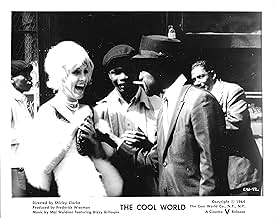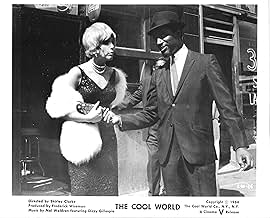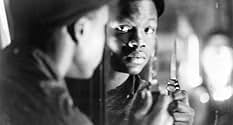Agrega una trama en tu idiomaA look at the horrors of Harlem ghetto slum life filled with drugs, violence, human misery, and a sense of despair due to the racial prejudices of American society.A look at the horrors of Harlem ghetto slum life filled with drugs, violence, human misery, and a sense of despair due to the racial prejudices of American society.A look at the horrors of Harlem ghetto slum life filled with drugs, violence, human misery, and a sense of despair due to the racial prejudices of American society.
- Dirección
- Guionistas
- Elenco
- Premios
- 1 premio ganado y 1 nominación en total
Rony Clanton
- Duke
- (as Hampton Clanton)
Clarence Williams III
- Blood
- (as Clarence Williams)
John Marriott
- Hurst
- (as John Marriot)
Joe Dennis
- Douglas Thurston
- (as Joseph Dennis)
Teddy McCain
- The Kids: Saint
- (as Ted McCain)
Opiniones destacadas
"The Cool World", a 1963 independent film directed by Shirley Clarke is probably the most shocking, interesting, and realistic film I have ever seen. The films follows the character of Duke played by Rony Clanton. This film shows how it really was to be an African American teen growing up in urban America (Harlem, N.Y.) in the 1960's. The gun serves as a character in the film itself, for it demonstrates manhood for the character of Duke.
By no means is this film a glorification of street life that is so common today in American pop culture. The viewer will see in this film how ugly crime is especially these characters who are driven to commit crimes because of the desperate, depressed situations of the ghetto. The character of Duke searches throughout this movie for a gun to own as almost a way to arm himself against the failures that surround him daily such as rat infested tenements, garbage filled streets, drugs, pimps, prostitutes, gangs, and over zealous cops.
If John Cassevetes is considered the new phase of film making that occurred in the late 1950's with his superb film "Shadows" then Shirley Clarke is his female counterpart. Shirley Clarke masterfully merges documentary footage and Jazz music to the actual film that creates somewhat of a frightening, haunting, realistic portrait of urban America that I feel has not been seen very much in cinema since "The Cool World". It is interesting to note that actors Clarence Williams III, Antonio Fargas, Gloria Foster, and Peter De Anda who appeared in this film went on to make great strides of achievement in both film and television in the 1970's.
"The Cool World" is shown in many film festivals across the country. Unfortunately it is not on video, but someday I hope it will be for the world to see. I rate this movie **** excellent.
By no means is this film a glorification of street life that is so common today in American pop culture. The viewer will see in this film how ugly crime is especially these characters who are driven to commit crimes because of the desperate, depressed situations of the ghetto. The character of Duke searches throughout this movie for a gun to own as almost a way to arm himself against the failures that surround him daily such as rat infested tenements, garbage filled streets, drugs, pimps, prostitutes, gangs, and over zealous cops.
If John Cassevetes is considered the new phase of film making that occurred in the late 1950's with his superb film "Shadows" then Shirley Clarke is his female counterpart. Shirley Clarke masterfully merges documentary footage and Jazz music to the actual film that creates somewhat of a frightening, haunting, realistic portrait of urban America that I feel has not been seen very much in cinema since "The Cool World". It is interesting to note that actors Clarence Williams III, Antonio Fargas, Gloria Foster, and Peter De Anda who appeared in this film went on to make great strides of achievement in both film and television in the 1970's.
"The Cool World" is shown in many film festivals across the country. Unfortunately it is not on video, but someday I hope it will be for the world to see. I rate this movie **** excellent.
This film is a tremendous achievement. It is unbelievable to me that it is not being preserved and protected by those who have the power to do so. It absolutely SHOULD be available on video and it should be regularly mentioned in discussions of the great films of the "American New Wave". The previous commenter was absolutely right to compare it to a Cassavettes picture because it has a very similar feel, in that it seems not so much like a movie with a narrative, but just a "snippet" of a time, almost taken randomly for two hours. We get all kinds of wonderful experiences in that two hours, including 1960's Harlem, disillusioned youth run amok, gritty street fare, etc. Not to mention the music in the film(a fantastic jazz soundtrack). This is a very valuable film, and the fact that it is directed by a woman is significant, as this seems to be an under-appreciated voice in American cinema. Criterion, let's get it together and get this available for people to see. OK?
After filming 'The Connection' in one room, Shirley Clarke this time came closest to making a classical feature film by taking to the mean streets of Harlem with a camera crew for this cinema verite equivalent of 'West Side Story', with a vivid jazz score by Mal Waldron; this time the rival gangs both being black, the hero belonging to the Pythons, whose mortal foes are The Wolves.
Shirley Clarke is one of those filmmakers I've heard about but I never seen any of her films, until now.
In New York at this time Cassavetes and many other filmmakers were doing films outside of the Hollywood system and tried to tell a different kind of film.
Shirley Clarke was definitely a part of this filmmovement using and deploying the same kind of style, tone and content.
This socialrealistic, gritty, dramadocumentary about street life in Harlem in 60's seen from a very young African American male by the name of Duke who joins a gang called the Pythons and starts waging a war against a rival gang called the Wolfs, is interesting albeit very flawed film experience.
At times this film is reminiscent of Cassavetes but being a very flawed film, the use of stock footage, voice-over, improvisational acting, etc means that Clarke sometimes ends up being a protegé to b-moviemaker Doris Wishman.
It may seem odd that I'm comparing the two but at times these two filmmakers seem to have a lot in common.
At best this film comes across as very dark, realistic portrayal of inner city youth crime in 60's. The film doesn't shy away from drugabuse, prostitution, interracial relationships etc.
Strangely, this film hasn't been released on DVD nor have Criterion, Masters of cinema etc released her films in a DVD box.
Shirley Clarke should get that treatment, she deserves it. And this film should be seen by more people interested in early American independent cinema.
In New York at this time Cassavetes and many other filmmakers were doing films outside of the Hollywood system and tried to tell a different kind of film.
Shirley Clarke was definitely a part of this filmmovement using and deploying the same kind of style, tone and content.
This socialrealistic, gritty, dramadocumentary about street life in Harlem in 60's seen from a very young African American male by the name of Duke who joins a gang called the Pythons and starts waging a war against a rival gang called the Wolfs, is interesting albeit very flawed film experience.
At times this film is reminiscent of Cassavetes but being a very flawed film, the use of stock footage, voice-over, improvisational acting, etc means that Clarke sometimes ends up being a protegé to b-moviemaker Doris Wishman.
It may seem odd that I'm comparing the two but at times these two filmmakers seem to have a lot in common.
At best this film comes across as very dark, realistic portrayal of inner city youth crime in 60's. The film doesn't shy away from drugabuse, prostitution, interracial relationships etc.
Strangely, this film hasn't been released on DVD nor have Criterion, Masters of cinema etc released her films in a DVD box.
Shirley Clarke should get that treatment, she deserves it. And this film should be seen by more people interested in early American independent cinema.
What we have here is one of the most honest depictions of a culture I've seen in an American film. The montages of the streets of Harlem with the voice over feels like a poetic travelogue of a place and time you don't want to visit. This film also feels far ahead of its time, showing stuff you wouldn't see in Hollywood for at least another decade. I can see how this movie could have inspired the early features of Ralph Bakshi with its style and broad focus on urban characters from NYC.
Unfortunately this film is pretty obscure which means that tracking down a decent copy is hard, but it is possible to find a very grainy copy on YouTube.
Unfortunately this film is pretty obscure which means that tracking down a decent copy is hard, but it is possible to find a very grainy copy on YouTube.
¿Sabías que…?
- TriviaIncluded among the "1001 Movies You Must See Before You Die", edited by Steven Schneider.
Selecciones populares
Inicia sesión para calificar y agrega a la lista de videos para obtener recomendaciones personalizadas
Detalles
- Fecha de lanzamiento
- País de origen
- Sitio oficial
- Idioma
- También se conoce como
- Die lässige Welt
- Locaciones de filmación
- Productoras
- Ver más créditos de la compañía en IMDbPro
- Tiempo de ejecución1 hora 45 minutos
- Color
- Mezcla de sonido
- Relación de aspecto
- 1.37 : 1
Contribuir a esta página
Sugiere una edición o agrega el contenido que falta

Principales brechas de datos
By what name was The Cool World (1963) officially released in Canada in English?
Responda



















